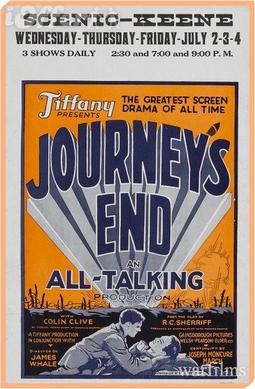“Journey’s End” was an early talkie that was released
the same year as “All Quiet on the Western Front”. It is also about WWI trench warfare, but it
is based on a popular play by R.C. Sherriff.
It was directed by James Whale (who that same year directed the dialogue
scenes in “Hell’s Angels”). The movie
was remade as “Aces High” with the scenario shifted to a Royal Flying Corps
squadron.
The movie is set in March, 1918 near St. Quentin in
France. Soldiers are moving up to a
front line trench during a bombardment.
The movie is a small unit movie that focuses on a group of Tommies. They are led by Capt. Stanhope (Colin Clive)
who is a very seasoned veteran who is using alcohol as a crutch. He represents the disillusionment with the
war. He is ably served by Lt. Osborne
(Ian MacLaren) who is called “Uncle” because he is elderly and wise. One of the men named Hibbert (Anthony
Bushell) is a malingerer. He blames
his cowardice on “neuralgia”. Stanhope
is a good leader but he is on edge and things get more tense when a young man
named Raleigh (David Manners) arrives from Stanhope’s home town. Raleigh idolizes Stanhope, but the veteran is
worried that Raleigh will reveal to his sister (who happens to be Stanhope’s
fiancé) that Stanhope is a changed man who relies on alcohol to function. The film covers a week in these men’s
lives. It includes a trench raid and
defense against a German attack.
“Journey’s End” is a micro look at life in the
trenches. Since it is based on a play,
it is dialogue driven. You better like
talking because there is a lot of it. Thankfully,
the soldier banter is natural and holds up well. There is some typically British humor. The movie manages to go beyond the stage by
having some outside scenes that are well done.
There is not a lot of action, but the trench raid and the German attack
add some pop. No man’s land is realistic
as are the sound effects associated with it.
The dugout also has verisimilitude.
The acting is excellent and the characters are interesting, especially
Stanhope. They seem familiar because the
movie was influential in the development of WWI archetypes.
“Journey’s End” fits squarely in the anti-war
realm. The vibe from the very beginning
prepares you for the deaths of most of the main characters. It is not a happy movie. Still, “war is hell” and most war movies
should make this clear. I have not read
the play but I assume the movie contains most, if not all, of the dialogue. Thus, even more than a book being converted
into a movie, a play should be improved by being made into a movie. Whale was able to add the action scenes to
enhance the already strong dialogue and plot.
Classic or antique?
Definitely a classic and a must see.
GRADE = B

No comments:
Post a Comment
Please fell free to comment. I would love to hear what you think and will respond.